
Table of Contents
Scientific Classification
- Kingdom: Animalia
- Phylum: Chordata
- Class: Reptilia
- Order: Squamata
- Family: Helodermatidae
- Genus: Heloderma
- Species: H. suspectum
Quick Overview
The Gila Monster (Heloderma suspectum) stands out as one of only two venomous lizards globally. It can be found in the southwestern United States and northwestern Mexico. The lizard’s striking patterned skin and venomous bite serve as a beacon of both curiosity and caution.
Fast Facts
- Scientific Name: Heloderma suspectum
- Lifespan: Up to 20 years in the wild; can potentially exceed this in captivity with proper care.
- Average Size: 1.5-2 feet in length.
- Diet: Carnivorous.
- Habitat: Desert, scrublands, and mesquite habitats.
Did you know?
The name “Gila” is derived from the Gila River Basin in Arizona, where these creatures were first identified.
Appearance
Gila Monsters display beaded scales that present a spectrum of colors from black to pink, orange, or yellow. This not only aids in camouflage but also acts as a conspicuous warning. Their robust physique and extended tail further punctuate their distinctive look.
Size and Weight
These lizards usually measure between 1.5 to 2 feet, with their tail making up over half of the total length. They typically weigh up to 5 pounds, positioning them among the largest native lizards in the U.S.
Temperament and Behavior
While they may come across as sluggish and inactive, Gila Monsters can become aggressive if provoked. However, they’re not naturally aggressive toward humans. They predominantly stay underground, sheltering from the desert’s intense heat, but become more active during cooler evenings or after rainfalls.
Fun Fact
The Gila Monster’s venom is potent. Though its bite is deliberate and rare, it’s extremely painful. However, fatalities in humans are exceptionally rare.
Habitat and Distribution
This species is native to the Mojave, Sonoran, and Chihuahuan deserts, covering parts of the southwestern U.S. and northwestern Mexico. They have a preference for rocky foothills and tend to avoid open terrains.
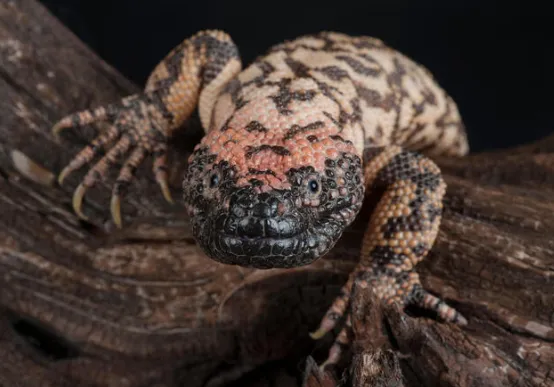
Diet and Nutrition
Primarily carnivores, Gila Monsters hunt bird and reptile eggs, small mammals, birds, frogs, and insects. Their acute sense of smell assists them in locating buried eggs.
Health and Wellness
Under captive conditions, Gila Monsters might face health issues like respiratory infections, abscesses, and metabolic disorders. Ensuring an appropriate diet, a conducive environment, and consistent veterinary attention can alleviate these risks.
Breeding
After mating, female Gila Monsters lay clutches, usually consisting of 8-23 eggs, in burrows. Approximately four months later, the hatchlings emerge, already equipped for independence.
Conservation Status
As of 2023, the Gila Monster is classified as “Near Threatened” by the IUCN Red List. However, they benefit from protection under state laws in the U.S. The primary threats to their survival include habitat destruction and illegal collection for the pet trade. Continued conservation efforts are essential to protect these splendid reptiles.
Fun Fact
Gila Monster venom has led to medical breakthroughs. Specifically, Exenatide, a drug formulated from a peptide in their venom, plays a vital role in type 2 diabetes treatments.
Photo Gallery
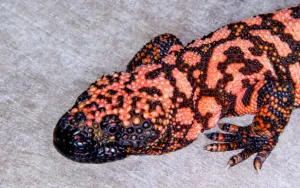
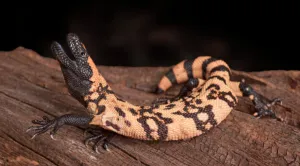
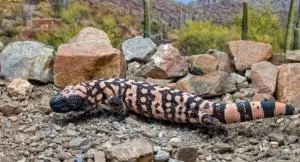
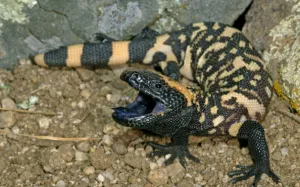

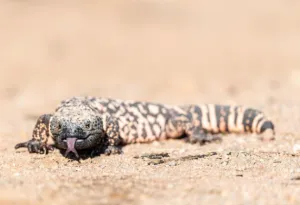
Check out the video below about Gila Monster:
Related Profiles
Share This Profile:
3 Amazing Facts About Gila Monster
- Venomous Defense: As one of the only venomous lizards globally, the Gila Monster uses its venom mainly for self-defense rather than for hunting.
- Desert Survivor: Despite living in demanding arid regions, Gila Monsters can thrive for up to two decades in the wild.
- Adapted for Scarcity: The Gila Monster’s tail stores fat, allowing the reptile to endure long intervals without
food — a critical adaptation for desert survival.
- Enchi Ball Python: A Unique and Stunning Morph of Python regius - March 27, 2025
- Emerald Tree Monitor: The Enigmatic Green Guardian of the Rainforest - March 26, 2025
- The Egyptian Cobra (Naja haje): A Fascinating Serpent - March 25, 2025
